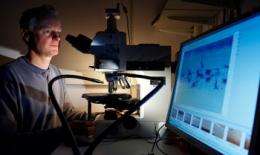A greater understanding of cells helps scientists understand how they function incorrectly - potentially increasing our understanding of cancer.
(Medical Xpress) -- University of Bath researchers have developed a new approach to studying cells that gives a much clearer picture of the intricate details of how they work.
The findings, published today in PLoS Genetics journal, could have implications for understanding and treating many diseases at cell level, including cancer, caused when the cell starts to function incorrectly.
In order truly to understand how a cell works, and how it goes wrong, scientists must have an accurate picture of how the active genes in a normal healthy cell interact.
Dr. Robert Kelsh from the Department of Biology and Biochemistry has been working on the project. He said: “Traditionally cells have been studied purely through genetic approaches. We took a rather novel approach, combining traditional genetics with mathematical modelling to allow a far more rigorous appraisal of our understanding of how the cell works.”
Geneticists produce genetic diagrams of cells which can very quickly become extremely complicated and impossible to read by intuition alone.
Dr. Kelsh worked with a colleague from the Department of Mathematical Sciences, Dr. Rocco, to incorporate mathematical modelling in his study of the cell. This approach restrains the researcher’s intuition about the genetic architecture of the cell and forces them to look rigorously at what the genetic diagram actually implies.
Dr. Kelsh said: “We used our genetic data to draw an initial diagram and then applied mathematical modelling to it, to assess the mathematical predictions of that diagram. We then used existing and new experimental data to test those predictions; where necessary, we then rethought our understanding of the cell and redrew the diagram. We went through this process three times, creating a more accurate picture of the cell each time.”
The research team developed their technique through studying melanocyte (skin) cells, but say that it could easily be adapted by scientists studying other cells in the body and could help in developing a much clearer picture of what happens at a cell level when diseases occur.
Through understanding exactly what changes take place in melanocyte cells during the onset of diseases such as melanoma (skin cancer), scientists can work towards developing methods for reversing or preventing these changes, and halting the progression of the disease.
Dr. Kelsh said: “This research is an on-going collaboration between mathematical modelling and biology. We are now looking in more detail at the core of the cell model we have come up with, and are hoping to secure additional funding to extend the research and further develop this combined-approach technique.”
More information: Greenhill ER, Rocco A, Vibert L, Nikaido M, Kelsh RN (2011) An Iterative Genetic and Dynamical Modelling Approach Identifies Novel Features of the Gene Regulatory Network Underlying Melanocyte Development. PLoS Genet 7(9): e1002265. doi:10.1371/journal.pgen.1002265
Provided by University of Bath


















